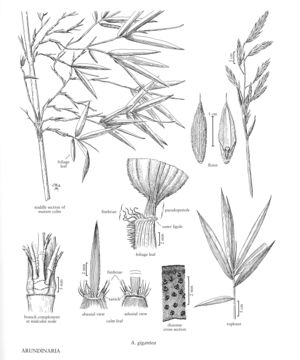Difference between revisions of "Arundinaria gigantea"
FNA>Volume Importer |
FNA>Volume Importer |
||
| Line 7: | Line 7: | ||
|synonyms={{Treatment/ID/Synonym | |synonyms={{Treatment/ID/Synonym | ||
|name=Arundinaria tecta var. distachya | |name=Arundinaria tecta var. distachya | ||
| − | |authority= | + | |authority= |
| + | |rank=variety | ||
}} {{Treatment/ID/Synonym | }} {{Treatment/ID/Synonym | ||
|name=Arundinaria macrosperma | |name=Arundinaria macrosperma | ||
| − | |authority= | + | |authority= |
| + | |rank=species | ||
}} {{Treatment/ID/Synonym | }} {{Treatment/ID/Synonym | ||
|name=Arundinaria gigantea subsp. macrosperma | |name=Arundinaria gigantea subsp. macrosperma | ||
| − | |authority= | + | |authority= |
| + | |rank=subspecies | ||
}} | }} | ||
|hierarchy=Poaceae;Poaceae subfam. Bambusoideae;Poaceae tribe Bambuseae;Arundinaria;Arundinaria gigantea | |hierarchy=Poaceae;Poaceae subfam. Bambusoideae;Poaceae tribe Bambuseae;Arundinaria;Arundinaria gigantea | ||
| Line 26: | Line 29: | ||
-->{{Treatment/Body | -->{{Treatment/Body | ||
|distribution=Ala.;Ark.;Fla.;Ga.;Ill.;Ind.;Kans.;Ky.;La.;Mo.;Miss.;N.C.;Ohio;Okla.;S.C.;Tenn.;Tex.;Va.;W.Va.;Del.;N.J.;N.Y.;Md. | |distribution=Ala.;Ark.;Fla.;Ga.;Ill.;Ind.;Kans.;Ky.;La.;Mo.;Miss.;N.C.;Ohio;Okla.;S.C.;Tenn.;Tex.;Va.;W.Va.;Del.;N.J.;N.Y.;Md. | ||
| − | |discussion=<p>Arundinaria gigantea forms extensive colonies in low woods, moist ground, and along river banks. It was once widespread in the southeastern United States, but cultivation, burning, and overgrazing have destroyed many stands.</p> | + | |discussion=<p><i>Arundinaria gigantea</i> forms extensive colonies in low woods, moist ground, and along river banks. It was once widespread in the southeastern United States, but cultivation, burning, and overgrazing have destroyed many stands.</p> |
|tables= | |tables= | ||
|references= | |references= | ||
| Line 35: | Line 38: | ||
-->{{#Taxon: | -->{{#Taxon: | ||
name=Arundinaria gigantea | name=Arundinaria gigantea | ||
| − | |||
|authority=(Walter) Muhl. | |authority=(Walter) Muhl. | ||
|rank=species | |rank=species | ||
| Line 42: | Line 44: | ||
|basionyms= | |basionyms= | ||
|family=Poaceae | |family=Poaceae | ||
| − | |illustrator=Cindy Roché | + | |illustrator=Cindy Roché;Annaliese Miller |
| + | |illustration copyright=Utah State University | ||
|distribution=Ala.;Ark.;Fla.;Ga.;Ill.;Ind.;Kans.;Ky.;La.;Mo.;Miss.;N.C.;Ohio;Okla.;S.C.;Tenn.;Tex.;Va.;W.Va.;Del.;N.J.;N.Y.;Md. | |distribution=Ala.;Ark.;Fla.;Ga.;Ill.;Ind.;Kans.;Ky.;La.;Mo.;Miss.;N.C.;Ohio;Okla.;S.C.;Tenn.;Tex.;Va.;W.Va.;Del.;N.J.;N.Y.;Md. | ||
|reference=None | |reference=None | ||
| Line 48: | Line 51: | ||
|publication year= | |publication year= | ||
|special status= | |special status= | ||
| − | |source xml=https:// | + | |source xml=https://jpend@bitbucket.org/aafc-mbb/fna-data-curation.git/src/f50eec43f223ca0e34566be0b046453a0960e173/coarse_grained_fna_xml/V24/V24_10.xml |
|subfamily=Poaceae subfam. Bambusoideae | |subfamily=Poaceae subfam. Bambusoideae | ||
|tribe=Poaceae tribe Bambuseae | |tribe=Poaceae tribe Bambuseae | ||
Revision as of 21:16, 16 December 2019
Rhizomes normally remaining horizontal, sometimes hollow-centered, air canals absent. Culms 2-8 m tall, to 3 cm thick; internodes typically sulcate distal to the branches. Culm leaves deciduous; sheaths 9-15 cm; fimbriae 2.2-7 mm; blades 1.5-3.5 cm. Topknots of 6-8 leaves; blades 16-24 cm long, 2-3.2 cm wide, lanceolate to ovate-lanceolate. Primary branches to 25 cm, erect or nearly so, with 0-1 compressed basal internodes, lower elongated internodes flattened in cross section. Foliage leaves: abaxial ligules usually ciliate, sometimes glabrous; blades subcoriaceous, persistent, evergreen, 8-15 cm long, 0.8-1.3 cm wide, bases rounded, abaxial surfaces glabrous or pubescent, strongly cross veined, adaxial surfaces glabrous or almost so. Spikelets 4-7 cm, greenish or brownish, with 8-12 florets. Glumes unequal, glabrous or pubescent, lowest glumes obtuse to acuminate or absent; lemmas 1.2-2 cm, usually appressed-hirsute to canescent, sometimes pubescent only towards the base and margins. Caryopses oblong, beaked, without a style branch below the beaks. 2n = 48.
Distribution
Ala., Ark., Fla., Ga., Ill., Ind., Kans., Ky., La., Mo., Miss., N.C., Ohio, Okla., S.C., Tenn., Tex., Va., W.Va., Del., N.J., N.Y., Md.
Discussion
Arundinaria gigantea forms extensive colonies in low woods, moist ground, and along river banks. It was once widespread in the southeastern United States, but cultivation, burning, and overgrazing have destroyed many stands.
Selected References
None.
